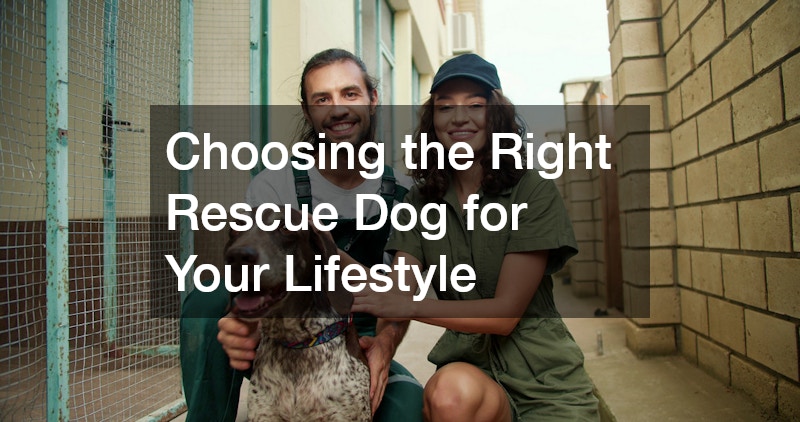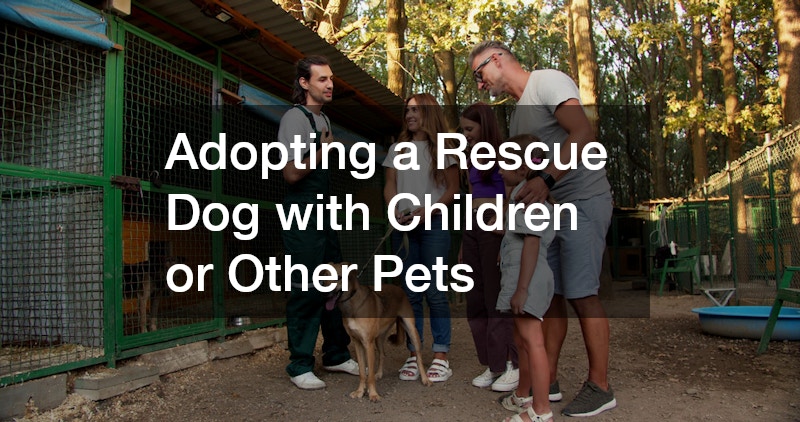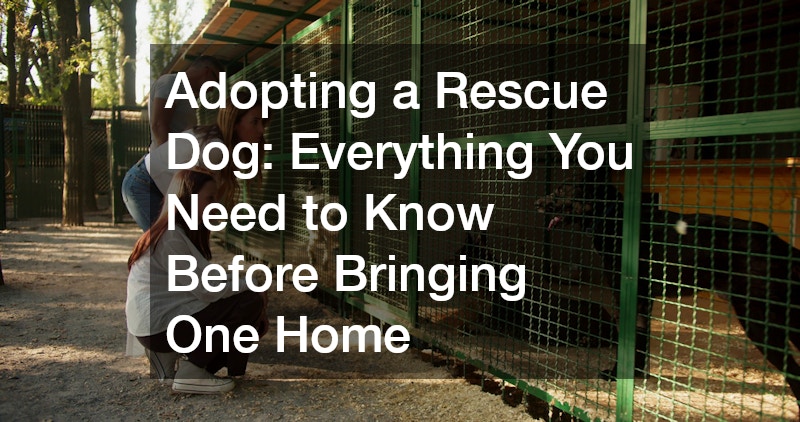
Adopting a rescue dog is among the best decisions you’ll ever make. Not only are you giving a second chance to a dog in need, but you’re also gaining a loyal companion who may have never experienced love or stability before. However, adopting a rescue dog isn’t the same as buying a puppy from a breeder. It requires patience, preparation, and a deep understanding of what your new furry friend might have been through.
This guide covers everything you need to know before bringing a rescue dog home — from emotional preparation to supplies, adjustment tips, and long-term care. Whether you’re a first-time dog parent or a seasoned pet owner looking to adopt, this article will help you make the transition smooth and successful.
Why Adopt a Rescue Dog?
Before diving into the “how,” it’s important to revisit the “why.” Rescue dogs often come from heartbreaking situations—neglect, abuse, abandonment, or natural disasters. When you adopt one, you’re literally saving a life and freeing up shelter space for another animal in need.
Beyond that, rescue dogs tend to be deeply appreciative of their second chance. While they may come with quirks or trauma, many adopters find that rescue dogs show an unmatched level of loyalty and love. Plus, adoption is a more ethical alternative to buying from breeders or pet stores, especially given the overpopulation of animals in shelters.
Are You Really Ready for a Rescue Dog?
Adopting a rescue dog is a long-term commitment. It’s not a temporary fix for loneliness or a trend to try out. Dogs live 10–15 years (or more), and many rescue dogs may require extra time and attention due to past trauma or neglect.
Ask yourself:
- Do I have the time and energy? Dogs need daily exercise, training, and affection.
- Can I afford a pet? Vet visits, food, grooming, and emergency care can add up.
- Is my home suitable for a dog? Consider space, safety, and pet-friendliness.
- Am I emotionally ready? Rescue dogs may not bond with you immediately or act perfectly right away.
If you can honestly say “yes” to these, then you’re ready to move to the next step.
Choosing the Right Rescue Dog for Your Lifestyle

With hundreds of dogs available through shelters and rescue organizations, it’s crucial to find one that suits your personality and daily routine. Don’t just fall in love with a photo — take time to assess compatibility.
Things to Consider:
- Size: Bigger dogs need more space and exercise.
- Energy level: Are you active or laid-back? Match accordingly.
- Temperament: Some dogs are great with kids, others may need quieter homes.
- Age: Puppies require training; older dogs might already be housebroken.
- Special needs: Be realistic about your ability to care for dogs with disabilities or trauma.
Tip:
Work with shelter staff to assess temperament. Ask for a trial period or foster-to-adopt option if available.
What Supplies Do You Need Before Bringing a Rescue Dog Home?
Before your new dog steps into your home, it’s important to prepare the space and gather essential items. Think of it like baby-proofing — but for a very curious and possibly anxious new pet.
Must-Have Items:
- Collar with ID tag
- Leash and harness
- Crate (for training and safety)
- Comfortable dog bed
- Food and water bowls
- High-quality dog food
- Toys (for mental stimulation)
- Treats for training
- Poop bags and cleaning supplies
- Basic grooming tools (brush, nail clippers)
Also, identify a local veterinarian in advance and schedule a check-up within the first week of adoption.
Bringing Your Rescue Dog Home: What to Expect in the First 72 Hours
The first three days are critical. This is when your dog is most anxious and unsure of their new surroundings. Don’t expect tail wags and cuddles right away. Some dogs will hide, others might bark excessively, and some may not eat or sleep well.
Do’s and Don’ts:
- Give them space — Let your dog explore at their own pace.
- Stick to a routine — Consistency helps build trust.
- Use positive reinforcement — Reward calm behavior and curiosity.
- Don’t overwhelm with visitors — Let them bond with you first.
- Avoid scolding — Correct gently, and focus on praise.
Be patient. This transition phase may take days or even weeks.
Understanding Your Rescue Dog’s Behavior
Rescue dogs often come with emotional baggage. Their behavior might not make sense at first, but remember — fear, confusion, or past trauma can influence how they act.
Common Behaviors You Might Notice:
- Hiding or avoiding contact
- Excessive barking or chewing
- House-training accidents
- Food guarding or aggression
- Separation anxiety
How to Help:
- Stick to positive reinforcement training
- Use calm, predictable routines
- Consider consulting a professional dog trainer or behaviorist, especially if issues persist.
Building trust takes time. What seems like “bad behavior” may actually be a cry for help.
Adopting a Rescue Dog with Children or Other Pets

Introducing a rescue dog into a home with kids or other animals requires special care. Children might not understand boundaries, and existing pets could feel threatened.
Tips for a Smooth Introduction:
- Start slow — Keep early interactions brief and supervised.
- Educate children — Teach them to respect the dog’s space.
- Use scent swapping — Let pets get used to each other’s scent before meeting.
- Have separate feeding areas — Prevent territorial aggression during mealtime.
Take it one day at a time. Gradual, supervised bonding usually leads to harmony.
The Importance of Vet Care and Health Checks
Schedule a full veterinary exam within the first week of adoption. Even if your rescue dog appears healthy, underlying conditions or untreated illnesses may exist.
Common Medical Needs:
- Vaccinations (rabies, distemper, parvo)
- Parasite control (fleas, ticks, worms)
- Dental checkup
- Microchipping
- Spaying/neutering (if not already done)
Regular checkups and preventive care will ensure a long, healthy life for your new companion.
Training and Socialization: Setting Your Rescue Dog Up for Success
Training isn’t just about obedience — it’s about building a communication bridge between you and your dog. Rescue dogs especially benefit from structure, boundaries, and positive social experiences.
Training Tips:
- Use rewards, not punishment
- Practice daily short sessions
- Keep commands consistent
- Enroll in group classes when ready
Socialization is also key. Slowly introduce your dog to new people, sounds, and environments. This helps prevent fear-based behaviors later.
Building a Bond: Creating a Loving and Safe Environment
Love isn’t built overnight. Rescue dogs may take weeks or months to fully trust you. The key is to stay calm, be consistent, and let the bond grow naturally.
Ways to Build Trust:
- Hand-feed them treats or meals
- Spend quiet time near them without forcing interaction
- Engage in daily walks or playtime
- Talk to them in a soft, calm voice
Eventually, you’ll see signs of affection: tail wags, cuddles, or following you around. These milestones are worth the wait.
How Long Does It Take a Rescue Dog to Adjust?
Adjustment timelines vary widely among rescue dogs. Some may settle in within a few days, while others can take several months to feel safe and comfortable. The “3-3-3 Rule” is a good guideline: 3 days to decompress, 3 weeks to learn your routine, and 3 months to feel fully at home. During this time, be patient and observant. Look for signs of progress like eating regularly, responding to their name, or initiating play. Remember, consistency is key. The more stable and loving the environment, the faster your rescue dog will adapt and begin to trust.
Should You Consider Fostering Before Adopting?
Fostering a rescue dog before adopting can be a great way to test compatibility and ease into pet ownership. Many shelters and rescue organizations offer “foster-to-adopt” programs, allowing you to care for a dog temporarily before making a permanent commitment. This experience helps you understand the dog’s needs, behavior, and energy level in a home setting. It’s also incredibly helpful for the dog, giving them a break from shelter life. Even if you don’t adopt the foster pet, you’re contributing to their journey and helping shelters better match them with a future forever family.
How to Help Your Rescue Dog Thrive Long-Term
Beyond the initial adjustment period, rescue dogs need ongoing care to truly thrive. Regular exercise, mental stimulation, and social interaction are essential. Keep vet appointments consistent and monitor for any changes in behavior or appetite. Enrichment activities like puzzle toys, new walking routes, or even agility training can boost confidence. Most importantly, continue building emotional security through positive reinforcement and daily bonding. Celebrate progress, no matter how small — even a wagging tail or a calm nap near you is a step forward. A rescue dog’s transformation over time is one of the most heartwarming parts of the journey.
Is Adopting a Rescue Dog Right for You? Final Thoughts
Adopting a rescue dog isn’t always easy, but it’s always worth it. These dogs come with pasts that may never be fully known, but your future together can be filled with joy, loyalty, and love.
Take your time during the adoption process. Prepare your home, heart, and schedule to accommodate the needs of a dog that’s learning to trust again. The rewards? Unmatched companionship and the satisfaction of knowing you’ve changed a life for the better.
